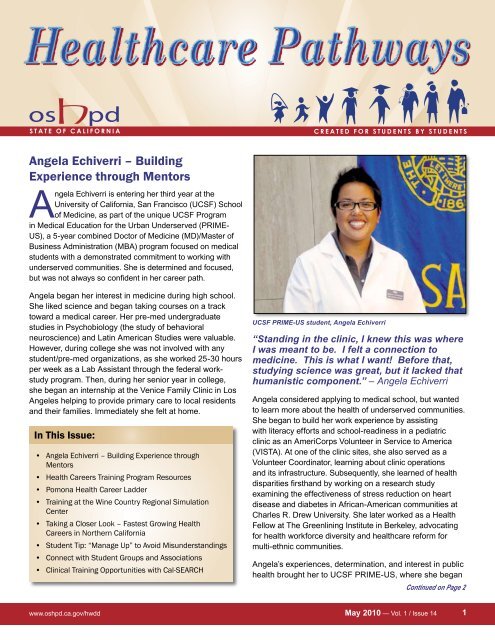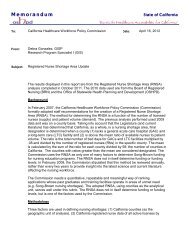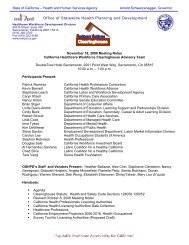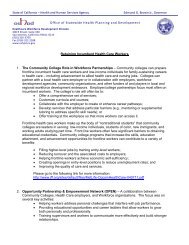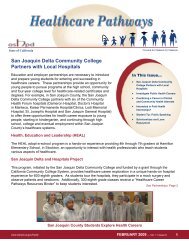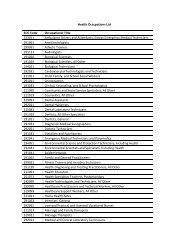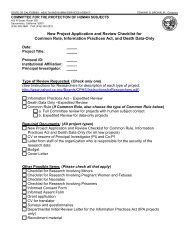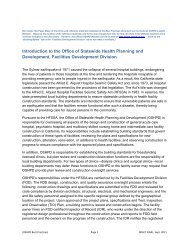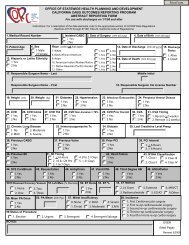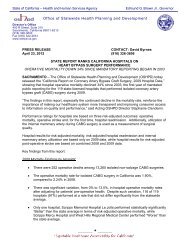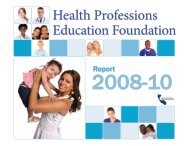Angela Echiverri - Office of Statewide Health Planning and ...
Angela Echiverri - Office of Statewide Health Planning and ...
Angela Echiverri - Office of Statewide Health Planning and ...
You also want an ePaper? Increase the reach of your titles
YUMPU automatically turns print PDFs into web optimized ePapers that Google loves.
S t a t e o f C a l i f o r n i a<br />
C r e a t e d f o r S t u d e n t s b y S t u d e n t s<br />
<strong>Angela</strong> <strong>Echiverri</strong> – Building<br />
Experience through Mentors<br />
<strong>Angela</strong> <strong>Echiverri</strong> is entering her third year at the<br />
University <strong>of</strong> California, San Francisco (UCSF) School<br />
<strong>of</strong> Medicine, as part <strong>of</strong> the unique UCSF Program<br />
in Medical Education for the Urban Underserved (PRIME-<br />
US), a 5-year combined Doctor <strong>of</strong> Medicine (MD)/Master <strong>of</strong><br />
Business Administration (MBA) program focused on medical<br />
students with a demonstrated commitment to working with<br />
underserved communities. She is determined <strong>and</strong> focused,<br />
but was not always so confident in her career path.<br />
<strong>Angela</strong> began her interest in medicine during high school.<br />
She liked science <strong>and</strong> began taking courses on a track<br />
toward a medical career. Her pre-med undergraduate<br />
studies in Psychobiology (the study <strong>of</strong> behavioral<br />
neuroscience) <strong>and</strong> Latin American Studies were valuable.<br />
However, during college she was not involved with any<br />
student/pre-med organizations, as she worked 25-30 hours<br />
per week as a Lab Assistant through the federal workstudy<br />
program. Then, during her senior year in college,<br />
she began an internship at the Venice Family Clinic in Los<br />
Angeles helping to provide primary care to local residents<br />
<strong>and</strong> their families. Immediately she felt at home.<br />
In This Issue:<br />
• <strong>Angela</strong> <strong>Echiverri</strong> – Building Experience through<br />
Mentors<br />
• <strong>Health</strong> Careers Training Program Resources<br />
• Pomona <strong>Health</strong> Career Ladder<br />
• Training at the Wine Country Regional Simulation<br />
Center<br />
• Taking a Closer Look – Fastest Growing <strong>Health</strong><br />
Careers in Northern California<br />
• Student Tip: “Manage Up” to Avoid Misunderst<strong>and</strong>ings<br />
• Connect with Student Groups <strong>and</strong> Associations<br />
• Clinical Training Opportunities with Cal-SEARCH<br />
UCSF PRIME-US student, <strong>Angela</strong> <strong>Echiverri</strong><br />
“St<strong>and</strong>ing in the clinic, I knew this was where<br />
I was meant to be. I felt a connection to<br />
medicine. This is what I want! Before that,<br />
studying science was great, but it lacked that<br />
humanistic component.” – <strong>Angela</strong> <strong>Echiverri</strong><br />
<strong>Angela</strong> considered applying to medical school, but wanted<br />
to learn more about the health <strong>of</strong> underserved communities.<br />
She began to build her work experience by assisting<br />
with literacy efforts <strong>and</strong> school-readiness in a pediatric<br />
clinic as an AmeriCorps Volunteer in Service to America<br />
(VISTA). At one <strong>of</strong> the clinic sites, she also served as a<br />
Volunteer Coordinator, learning about clinic operations<br />
<strong>and</strong> its infrastructure. Subsequently, she learned <strong>of</strong> health<br />
disparities firsth<strong>and</strong> by working on a research study<br />
examining the effectiveness <strong>of</strong> stress reduction on heart<br />
disease <strong>and</strong> diabetes in African-American communities at<br />
Charles R. Drew University. She later worked as a <strong>Health</strong><br />
Fellow at The Greenlining Institute in Berkeley, advocating<br />
for health workforce diversity <strong>and</strong> healthcare reform for<br />
multi-ethnic communities.<br />
<strong>Angela</strong>’s experiences, determination, <strong>and</strong> interest in public<br />
health brought her to UCSF PRIME-US, where she began<br />
Continued on Page 2<br />
www.oshpd.ca.gov/hwdd<br />
May 2010 — Vol. 1 / Issue 14
...“<strong>Angela</strong> <strong>Echiverri</strong>” (continued from page 1)<br />
an academic career toward a Master’s Degree (MBA) <strong>and</strong> Medical<br />
Doctorate Degree. Working with campus student organizations,<br />
such as the Latino Medical Student Association (LMSA) <strong>and</strong><br />
the Student National Medical Association (SNMA), she found<br />
colleagues, friends, <strong>and</strong> mentors. She has worked to recruit <strong>and</strong><br />
retain new students, especially those currently underrepresented,<br />
through community outreach <strong>and</strong> pre-medical conferences. She<br />
has become a mentor to high school <strong>and</strong> pre-med students through<br />
the UCSF MedLink program, LMSA <strong>and</strong> SNMA.<br />
“Much <strong>of</strong> my first year was spent adjusting to the<br />
rigors <strong>of</strong> medical school. After that, I felt OK <strong>and</strong><br />
was able to get involved in student organizations<br />
<strong>and</strong> mentoring activities to cultivate my passions<br />
<strong>and</strong> interests.” – <strong>Angela</strong> <strong>Echiverri</strong><br />
UCSF Latino Medical Students Association members<br />
Her goals are to continue taking care <strong>of</strong> families <strong>and</strong> watching them grow up together through primary care, specifically<br />
family medicine. She feels that in primary care, she can best advocate for social justice, combat health disparities, <strong>and</strong><br />
continue to directly help underserved communities. Continuing to mentor youth <strong>and</strong> encourage future generations to give<br />
back <strong>and</strong> help take care <strong>of</strong> our communities is also a priority.<br />
“I have been blessed with so many mentors, that I want to give back in the same way. I would<br />
like to help answer the question when medical students ask ...Do I belong? Am I fit to be<br />
here?” – <strong>Angela</strong> <strong>Echiverri</strong><br />
For more information on the UCSF PRIME-US program, please visit: http://medschool.ucsf.edu/prime/<br />
For more information on the UCSF MedLink program, please visit: http://rco.ucsf.edu/index.php/medlink<br />
For more information on AmeriCorps Volunteer in Service to America program, please visit: http://www.americorps.gov/<br />
For more information on The Greenlining Institute, please visit: http://www.greenlining.org/about/<br />
<strong>Health</strong> Careers Training<br />
Program Resources<br />
The new <strong>Health</strong> Careers Training Program<br />
site <strong>of</strong>fers information <strong>and</strong> resources to<br />
students including career exploration,<br />
education <strong>and</strong> pipeline programs, scholarships, <strong>and</strong> a calendar <strong>of</strong> events for upcoming career fairs, job trainings, <strong>and</strong><br />
other opportunities for learning <strong>and</strong> networking. Plan now for 2010!<br />
Please visit: http://www.oshpd.ca.gov/HWDD/HCTP_resources.html<br />
May 2010 — Vol. 1 / Issue 14<br />
www.oshpd.ca.gov/hwdd
Pomona <strong>Health</strong> Career Ladder<br />
A<br />
student pipeline program was started in the<br />
Pomona Valley in 2008 to guide <strong>and</strong> assist<br />
students through a successful education <strong>and</strong><br />
into a career as a culturally competent healthcare<br />
pr<strong>of</strong>essional. The Pomona <strong>Health</strong> Career Ladder is<br />
a partnership between the Pomona Unified School<br />
District, California State Polytechnic University<br />
Pomona, <strong>and</strong> the Western University <strong>of</strong> <strong>Health</strong><br />
Sciences. The program guides middle school students<br />
through high school, onto an undergraduate degree<br />
at Cal Poly Pomona, followed by a graduate degree in<br />
the medical field at Western University.<br />
The program <strong>of</strong>fers intensive mentoring <strong>and</strong> advising<br />
for students through interest-appropriate activities<br />
in the areas <strong>of</strong> sports medicine, microbiology, <strong>and</strong><br />
community health. Approximately 160 students will<br />
participate during 2009-2010.<br />
Pomona <strong>Health</strong> Career Ladder students learn from healthcare pr<strong>of</strong>essionals<br />
“Parents have told us that they want more options<br />
for their children…more options after graduation, <strong>and</strong> the Career Ladder is a wonderful option that can help<br />
students begin while still (with us) in the school system,” noted Superintendent <strong>of</strong> Pomona Unified School District,<br />
Dr. Thelma Melendez de Santa Ana as the program was introduced to the community.<br />
Students start the program in the 6th <strong>and</strong> 7th grade by attending a series <strong>of</strong> Saturday academies presented with<br />
Spanish translation. Along with their parents, the students learn about the roles <strong>and</strong> duties <strong>of</strong> healthcare pr<strong>of</strong>essionals,<br />
including pharmacists, physical therapists, physician assistants, veterinarians, optometrists, <strong>and</strong> dentists. Valuable<br />
writing <strong>and</strong> presentation skills are also developed <strong>and</strong> sharpened during group projects which identify <strong>and</strong> address<br />
community issues <strong>and</strong> health disparities. Test taking <strong>and</strong> exam preparation skills are also enhanced, along with math<br />
<strong>and</strong> science skills.<br />
“There are great minds in Pomona, <strong>and</strong> the Career Ladder is designed to encourage their success,” noted J.<br />
Michael Ortiz, President, Cal Poly Pomona, in proud support <strong>of</strong> the program.<br />
When students begin health career training during their second year in the program, they are given white coats in<br />
a welcoming ceremony as a symbol <strong>of</strong> their journey to becoming a health pr<strong>of</strong>essional. With intensive academic<br />
mentoring, parent education, <strong>and</strong> practical h<strong>and</strong>s-on<br />
learning, students in the Pomona <strong>Health</strong> Career Ladder have<br />
a clear vision toward becoming healthcare pr<strong>of</strong>essionals who<br />
can meet the future health needs <strong>of</strong> their community.<br />
For more information on Western University <strong>of</strong> <strong>Health</strong><br />
Sciences, please visit:<br />
www.westernu.edu/xp/edu/home/home.xml<br />
View Western University’s “Roadmap to a <strong>Health</strong> Career” at:<br />
www.westernu.edu/ladder/roadmap.html<br />
For more information on California State Polytechnic<br />
University, Pomona, please visit:<br />
www.csupomona.edu/<br />
Pomona <strong>Health</strong> Career Ladder student activities<br />
www.oshpd.ca.gov/hwdd<br />
May 2010 — Vol. 1 / Issue 14
Training at the Wine Country Regional Simulation Center<br />
H<strong>and</strong>s-on learning in the healthcare industry<br />
not only builds clinical skills, but also assists<br />
students in their ability to make important<br />
decisions about patient treatment options. Gaining realworld<br />
experiences with real patients can come with high<br />
risks. To bridge this gap, a dedicated effort was initiated<br />
to introduce simulation technology to the Napa Valley.<br />
ever going to a hospital for training. During their nursing<br />
program, students are presented with a wide variety <strong>of</strong><br />
simulation scenarios which may take place in a home,<br />
a skilled nursing facility or a hospital. Students assess<br />
the patient, <strong>and</strong> administer medications <strong>and</strong> treatments<br />
while observing changes in health status. Students<br />
administering care must use their newly-developed<br />
clinical <strong>and</strong> critical thinking skills to respond to computergenerated<br />
changes in the patient’s vital signs, oxygen,<br />
or even skin color. If mistakes are made, no harm is<br />
done <strong>and</strong> students learn valuable lessons. Participants<br />
also have digital video feedback available to use during<br />
debriefing to reinforce the simulation training.<br />
The Wine Country Regional Simulation Center is an<br />
excellent example <strong>of</strong> technology <strong>and</strong> collaboration<br />
benefitting not only instructors <strong>and</strong> students, but also<br />
the quality <strong>of</strong> medical care, one decision at a time.<br />
For more information on the Wine Country Regional<br />
Simulation Center, please visit:<br />
http://www.napavalley.edu/Academics/<br />
<strong>Health</strong>Occupations/WCRSC/Pages/welcome.aspx<br />
Simulation training exercises<br />
The Wine Country Regional Simulation Center<br />
(WCRSC) provides an opportunity for nursing students<br />
to learn in realistic healthcare settings with interactive<br />
human models which take the place <strong>of</strong> real patients.<br />
These simulators are no “dummies,” but highly complex<br />
<strong>and</strong> state-<strong>of</strong>-the-art physiological models <strong>of</strong> human<br />
patients. Nursing students participate <strong>and</strong> interact with<br />
these patient models, reviewing test results, monitoring<br />
changes, <strong>and</strong> adjusting treatment options. <strong>Health</strong><br />
pr<strong>of</strong>essionals seeking continuing education also use<br />
the facilities to reinforce skills used in emergency or<br />
advanced treatment situations.<br />
Napa Valley College’s academic <strong>and</strong> program<br />
information can be found at:<br />
http://www.napavalley.edu<br />
Solano Community College’s academic <strong>and</strong><br />
program information can be found at:<br />
www.solano.edu<br />
The Wine Country Regional Simulation Center is located<br />
in Yountville, California at the Yountville Veterans Home,<br />
Holderman Hospital <strong>and</strong> is a joint effort <strong>of</strong> Napa Valley<br />
College <strong>and</strong> Solano Community College <strong>and</strong> funded<br />
through the Governor’s Nursing Education Initiative.<br />
Students in Napa Valley <strong>and</strong> Solano Community College<br />
nursing programs visit the simulation center as part <strong>of</strong><br />
the Associate Degree in Nursing Program (ADN), before<br />
Nursing students visit WCRSC<br />
May 2010 — Vol. 1 / Issue 14<br />
www.oshpd.ca.gov/hwdd
Taking a Closer Look – Fastest Growing <strong>Health</strong> Careers in Northern California<br />
Interested in pursuing a career in one <strong>of</strong> the allied health pr<strong>of</strong>essions in Northern California? The roles <strong>of</strong> allied health<br />
pr<strong>of</strong>essionals range from laboratory <strong>and</strong> technical work to diagnostic <strong>and</strong> direct care practitioners. Many <strong>of</strong> these jobs<br />
support <strong>and</strong> serve the community directly, assisting patients in every type <strong>of</strong> care setting.<br />
Allied health careers are among the fastest growing careers in the state. Many entry-level positions don’t require an<br />
advanced college degree, only a certificate which can be earned in one to two years. Becoming a lab scientist or<br />
providing treatment options to patients may require a graduate degree or more.<br />
Fastest Growing Allied <strong>Health</strong> Careers in the Greater Sacramento/ Northern California Region<br />
<strong>Health</strong> Occupation<br />
(26 counties total)<br />
Education<br />
Data from the November 2009 Report, “Allied <strong>Health</strong> Regional Workforce Analysis<br />
Sacramento/Northern California Region,” prepared by the UCSF Center for the <strong>Health</strong><br />
Pr<strong>of</strong>essions <strong>and</strong> supported by The California Endowment.<br />
2007 Average Annual<br />
Salary for Region<br />
Home <strong>Health</strong> Aide Certificate (
Student Tip: “Manage Up” to Avoid Misunderst<strong>and</strong>ings<br />
Good communication brings clarity to your busy day. How<br />
many times have misunderst<strong>and</strong>ings <strong>of</strong> a manager’s<br />
or instructor’s expectations caused you wasted time<br />
<strong>and</strong> effort? We <strong>of</strong>ten “manage up” (which is different from “kissing<br />
up”) to avoid mistakes. The best communication is two-way, but is<br />
effective only if you both speak the same language. The ability to<br />
communicate clearly can benefit you in any situation.<br />
According to Thomas Zuber <strong>and</strong> Erika James, pr<strong>of</strong>essors at Emory<br />
University, “managing up is the process <strong>of</strong> consciously working<br />
to obtain the best possible results for you, your boss, <strong>and</strong> your<br />
organization.” Of course, your academic career or job also benefits<br />
when you are known as someone who is easy to work with.<br />
Don’t expect others to figure out what you are trying to say! Follow these tips for better communication:<br />
“Quick Speak”<br />
Talk or Text?<br />
Don’t Mention It<br />
Are You Helping?<br />
Honesty <strong>and</strong> Loyalty<br />
Teachers, parents, pr<strong>of</strong>essors, <strong>and</strong> peers sometimes speak different<br />
“languages” by using unique phrases <strong>and</strong> “quick-speak” in conversation. Take<br />
notice <strong>and</strong> adjust your message in order to communicate more effectively.<br />
Is your instructor or boss a listener, email user or texter, or both? Is a written<br />
note or email/text enough or do you need to make a phone call reminder? Get<br />
to know how to quickly communicate important information.<br />
Watch out for the sensitive areas or pet peeves <strong>of</strong> those you communicate<br />
with regularly. Don’t mention things or act in ways that irritate or damage your<br />
relationships with others.<br />
When in a conversation with an instructor or boss, think about switching roles<br />
for a moment. Is a question being asked or is a problem being created? Be a<br />
solution, not a problem.<br />
The core <strong>of</strong> good communication is trust. Don’t be labeled a “problem” by<br />
covering up problems or failures. Be truthful to the best <strong>of</strong> your ability. After all,<br />
the truth will come out sooner or later.<br />
Overall, the effort to help your instructor or boss will<br />
benefit everyone in the end. It is a skill to be developed<br />
to enhance all your relationships. Using your strengths<br />
in communication to demonstrate your talents <strong>and</strong> hard<br />
work to others is a path to success.<br />
For more on “Managing Your Boss” by Thomas<br />
Zuber <strong>and</strong> Erika James, visit the American<br />
Academy <strong>of</strong> Family Physicians at:<br />
http://www.aafp.org/fpm/2001/0600/p33.html<br />
May 2010 — Vol. 1 / Issue 14<br />
www.oshpd.ca.gov/hwdd
Connect with Student Groups <strong>and</strong> Associations<br />
Student success is much more than achieving<br />
the best grade. A successful college experience<br />
connects our talents <strong>and</strong> passions with our daily<br />
lives toward a future attainable goal. For many students,<br />
that goal is a rewarding job in the healthcare industry.<br />
Just as there are many career paths to choose from,<br />
there are many ways to find friends, mentors, <strong>and</strong> fellow<br />
students who share similar dreams <strong>and</strong> similar cultural<br />
backgrounds. Campus organizations, associations, <strong>and</strong><br />
interest groups help students connect with each other,<br />
advocate for change, <strong>and</strong> <strong>of</strong>fer support through tough<br />
times <strong>and</strong> tough assignments. Organization members<br />
<strong>and</strong> alumni can also help you build real-world skills by<br />
partnering with healthcare pr<strong>of</strong>essionals involved in<br />
community outreach or youth-mentorship programs.<br />
Students can join some campus groups while still in high<br />
school. This early involvement can provide insight <strong>and</strong><br />
motivation to help you find your place in the healthcare<br />
industry. Premedical <strong>and</strong> undergraduate students needing<br />
to broaden their extra-curricular work experience can<br />
find workshops, leadership academies, internships, <strong>and</strong><br />
volunteer activities. You may soon find yourself organizing<br />
student events, coordinating workshops, or even becoming<br />
a mentor yourself!<br />
Choosing a field <strong>of</strong> study <strong>and</strong> finding a rewarding <strong>and</strong><br />
satisfying job takes time <strong>and</strong> effort, but having the advice<br />
<strong>and</strong> support <strong>of</strong> friends <strong>and</strong> mentors can be a great help,<br />
more than you can imagine! Take a moment to talk with<br />
or visit your campus student organization <strong>of</strong>fice or speak<br />
with students in your classes to find local opportunities to<br />
explore <strong>and</strong> grow.<br />
To learn more about student organizations in the<br />
healthcare industry, please visit the following links:<br />
American Medical Student Association (AMSA)<br />
www.amsa.org/AMSA/Homepage.aspx<br />
Asian Pacific American Medical Student<br />
Association (APAMSA)<br />
www.apamsa.org<br />
California Nursing Students’ Association (CNSA)<br />
www.cnsa.org<br />
<strong>Health</strong> Occupations Students <strong>of</strong> America (HOSA)<br />
www.hosa.org/<br />
Latino Medical Student Association (LMSA)<br />
http://west.lmsa.net/<br />
Student Physicians for Social Responsibility<br />
http://www.psr.org/chapters/student-chapters/<br />
Student National Medical Association (SNMA)<br />
www.snma.org/<br />
www.oshpd.ca.gov/hwdd<br />
May 2010 — Vol. 1 / Issue 14
Cal-SEARCH accepts<br />
students/residents enrolled<br />
in the following programs:<br />
DENTISTRY<br />
FAMILY MEDICINE<br />
PHYSICIAN ASSISTANTS<br />
FAMILY NURSE PRACTITIONERS<br />
ALLOPATHIC AND OSTEOPATHIC Medicine<br />
And other medical Disciplines...<br />
Clinical Training Opportunities with Cal-SEARCH<br />
Interested in a stipend for clinic-based training <strong>and</strong> participating<br />
in a community-based project? Don’t miss this exciting<br />
opportunity! Applications are now being accepted for clinical<br />
training opportunities as part <strong>of</strong> California’s first Student/<br />
Resident Experiences <strong>and</strong> Rotations in Community <strong>Health</strong><br />
Program (Cal-SEARCH).<br />
Selected applicants will participate in a 4-6 week clinical<br />
rotation <strong>and</strong> complete a community project! Students<br />
<strong>and</strong> residents <strong>of</strong> the following disciplines are eligible:<br />
physician assistant, family medicine, dentistry, family<br />
nurse practitioner, <strong>and</strong> allopathic & osteopathic<br />
medicine. Students <strong>of</strong> other disciplines are also<br />
encouraged to apply <strong>and</strong> will be considered –<br />
space permitting.<br />
To learn more <strong>and</strong> to apply online, please visit:<br />
http://www.oshpd.ca.gov/HWDD/Cal-SEARCH/index.html.<br />
This program is funded by U.S.<br />
Department <strong>of</strong> <strong>Health</strong> <strong>and</strong> Human<br />
Services, <strong>Health</strong> Resources <strong>and</strong><br />
Services Administration<br />
Cal-SEARCH<br />
<strong>Health</strong>care Pathways<br />
<strong>Office</strong> <strong>of</strong> <strong>Statewide</strong> <strong>Health</strong> <strong>Planning</strong> & Development<br />
<strong>Health</strong>care Workforce Development Division<br />
400 R Street, Room 330<br />
Sacramento, CA 95811<br />
(916) 326-3700<br />
www.oshpd.ca.gov/hwdd/<br />
<strong>Health</strong>care Pathways is a quarterly publication <strong>of</strong> the <strong>Office</strong> <strong>of</strong> <strong>Statewide</strong> <strong>Health</strong><br />
<strong>Planning</strong> <strong>and</strong> Development’s <strong>Health</strong>care Workforce Development Division.<br />
Please submit your comments, suggestions <strong>and</strong> ideas by phone at (916) 326-3700.<br />
State <strong>of</strong> California<br />
Arnold Schwarzenegger<br />
Governor<br />
California <strong>Health</strong> & Human Services Agency<br />
Kimberly Belshé<br />
Secretary<br />
<strong>Office</strong> <strong>of</strong> <strong>Statewide</strong> <strong>Health</strong> <strong>Planning</strong> &<br />
Development<br />
David M. Carlisle M.D., Ph.D.<br />
Director<br />
Stephanie Clendenin<br />
Interim Chief Deputy Director<br />
Anne Drumm<br />
Assistant Director for Legislative<br />
<strong>and</strong> Public Affairs<br />
<strong>Health</strong>care Workforce Development<br />
Division<br />
<strong>Angela</strong> L. Minniefield, M.P.A.<br />
Deputy Director<br />
Managing Editor<br />
Felicia M. Borges<br />
Manager<br />
<strong>Health</strong> Careers Training Program<br />
Staff Writers & Graphics<br />
Kevin Romero<br />
Program Coordinator<br />
<strong>Health</strong> Careers Training Program<br />
Guest Articles<br />
We welcome contributions.<br />
Send us your ideas, letters,<br />
announcements, or stories today!<br />
Announcements <strong>of</strong> scheduled events to be<br />
published must be mailed to our editorial<br />
<strong>of</strong>fice at least three months in advance. Be<br />
sure to include your name, address, <strong>and</strong><br />
telephone number on all correspondence.<br />
The <strong>Health</strong>care Pathways editorial staff<br />
reserves the right to edit all material.<br />
Please Recycle<br />
May 2010 — Vol. 1 / Issue 14<br />
www.oshpd.ca.gov/hwdd


